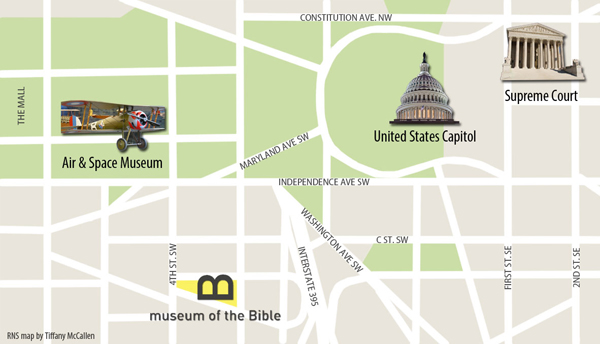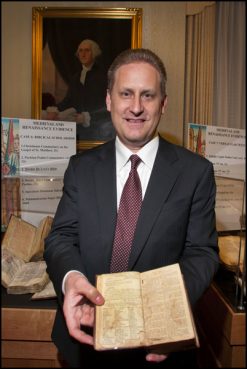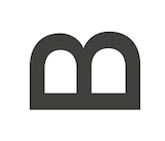WASHINGTON (RNS) Museum of the Bible.
That’s it.
The name of the museum under construction in Washington, D.C., is official.
“We don’t need more to tell people who and what we are,” the museum’s founder and funder, Steve Green, told Religion News Service.
But, as always with the Bible, nothing is ever simple.
The high-tech museum, set to open in fall 2017, is four blocks from the U.S. Capitol and three blocks from a global tourism mecca, the Air and Space Museum. The new museum will feature standing exhibits on the history and impact of the Bible as well as interactive features to bring viewers into Bible stories and characters.

The Museum of the Bible is located two blocks from the National Mall, at 300 D Street, SW. RNS map by Tiffany McCallen; Wikimedia Commons D.C. landmarks by Jarek Tuszynski, Ad Meskens, Diliff
It’s the passionate project of Green, the Hobby Lobby billionaire who would prefer to be known for his world-class Bible artifacts collection than for his victorious Supreme Court fight for exemption from the Affordable Care Act contraception mandate.

Exterior rendering of the Museum of the Bible, located three blocks from the U.S. Capitol in Washington, D.C. The eight-story, 430,000-square-foot museum is being designed by a team of consultants, including lead architect group SmithGroupJJR. Photo courtesy of SmithGroupJJR
Religious freedom, he says, is a biblical concept. The Green family — generations of Pentecostals and Baptists — has long funded Bible scholarship, biblical archaeology and the drafting of a proposed public school curriculum on the Bible’s historic, cultural and artistic impact on the U.S. and the world.
All are controversial endeavors, particularly given Green’s personal commitment to spread the good word about the Good Book.
Yet, Green insists, this is not an $800 million monument to personal evangelism. Unlike Answers in Genesis, the ministry that launched the Creation Museum in Kentucky and an Ark Encounter park under construction, employees need not pass a Christians-only litmus test. Green said believers, skeptics and the “intellectually curious” alike can visit and learn, just as they might at a science museum.
“The Bible can speak for itself, explain itself.”
Blowback since the museum’s announcement in 2011 doesn’t bother him. “Anytime you do anything with the Bible, people respond with emotion — emotion for and against it. That people want to express their love or their hate is not surprising.”
To Green, the controversies simply prove the timeless intrigue of the Bible. “There really isn’t a barrier for this book.”

Museum of the Bible Board Chairman Steve Green, with one of the more than 44,000 rare biblical texts and artifacts his family began collecting in 2009. Green has assembled a team of academics, designers, technology professionals and other experts to create a museum dedicated to a scholarly and engaging presentation of the impact, history and narrative of the Bible. The museum is scheduled to open in Washington, D.C., in fall 2017. Photo courtesy of Museum of the Bible
Hence, the simple, symbolic and super modern logo featuring a B-as-in-Bible set on its side.
Or is it a lowercase ‘m’ for museum, underscored?
Or a set of archways leading toward the path of your own choosing?
Or the tablets of the Ten Commandments?
Or the curled open pages of a book?
All the above, said Jonathan Alger, one of the founding partners of C&G Partners, the design firm that created the logo and brand imagery.
Like the Bible, the logo is “a vessel for what you pour into it.”
“When you are making an identity to reflect a museum about the Bible, it has to be simple and respectful,” Alger said.
His firm aimed for something “stylish, international, unexpected and very modern,” so even the typography mattered. Choice of the font was critical.
The museum signage and logo are in a European font known as DIN, “originally invented to make roadway signs in Europe more visible and safe. It was designed for clarity, to help people find their way.”
How very biblical.
YS/MG END GROSSMAN






